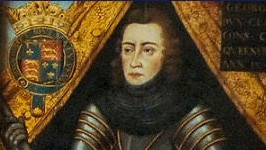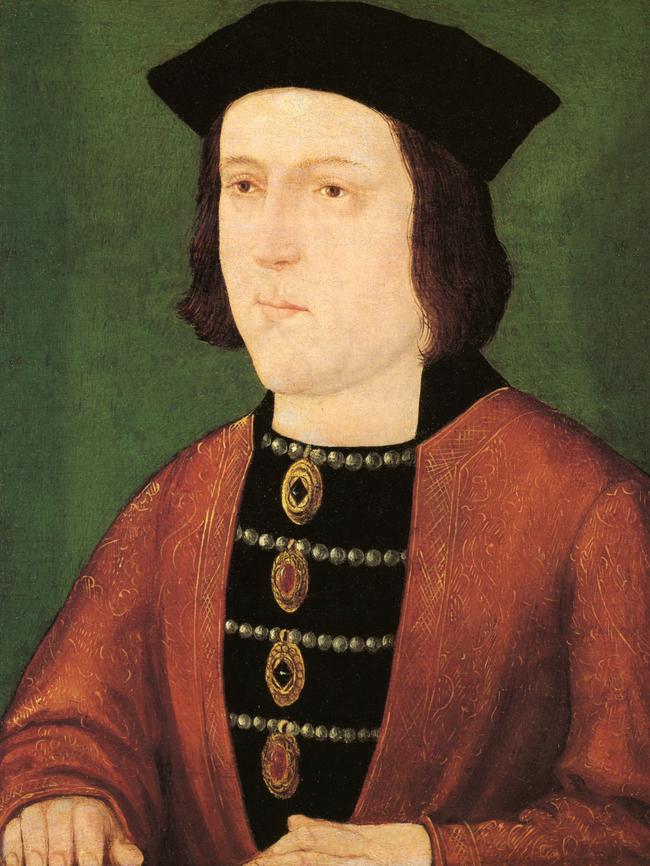Hooray Harry the latest in a long line of petulant princes
Selfishness and chicanery are qualities that run rampant in the Duke of Sussex’s royal bloodline.

Feckless young prince fights with elder brother over his choice of wife and moves abroad to plot revenge: George Duke of Clarence was certainly asking for trouble when he married Isabel Neville, elder daughter of the Earl of Warwick, on July 11, 1469.
His brother, King Edward IV, disapproved of the marriage, but Clarence took no notice, crossing the English Channel with his bride and soon-to-be father-in-law and marrying Isabel in Calais.
Like Harry Duke of Sussex, George Duke of Clarence was a brooding second son with a royal chip on his shoulder and too much time on his hands. The day after the wedding, ignoring Edward’s demands for them to return, the exiles wrote an open letter to the king, denouncing court hangers-on whose only interest was “their own promotion and enriching” and warning that unless he put the royal house in order, King Edward might go the way of his predecessors Edward II, Richard II and Henry VI, all unloved kings who met sticky ends in damp castles.
“False, fleeting, perjured Clarence” (as Shakespeare put it in Richard III) was, in the words of historian Dan Jones, “wilful, self-centred and infuriating … with a penchant for skulduggery and schemes”. Sound familiar?
For an institution rooted in duplicity, violence and betrayal, Prince Harry’s allegations of duplicity, violence and betrayal should come as no surprise, but his characterisation of Camilla, the Queen Consort, as a “villain” who would be the cause of “bodies left in the street” suggests a need to brush up on the deeds of his royal forbears. If vanilla Camilla is a villain, what does that make King Edward II’s French-born wife, Queen Isabella, who ran off with her lover, Roger Mortimer, while on a diplomatic mission to Paris and returned a year later to depose the king in favour of his son?
Things have rarely gone well for deposed English kings and Edward was left to rot in Berkeley Castle before becoming the victim of a “fatal accident”, possibly involving a red-hot poker.
Queen Isabella, who was famed for her beauty, intelligence and “diplomatic skills”, spent the next few years amassing land and money in time-honoured royal fashion, while the hapless Mortimer pushed his luck too far and was executed. Near the end of her life, Isabella tried to hedge her bets by becoming a nun but it did not save her from going down in history as the She-Wolf of France.
As for the Duke of Clarence, he did not stay abroad for long. Hounded by the tabloids and denied the book deal that would have paid for his personal security costs, he split from the Earl of Warwick and secretly reconciled with the king. In time, the quarrel over his choice of wife was quietly forgotten. Clarence retained his penchant for “skulduggery and schemes” but it turned out to be no match for that of his brothers, King Edward and Richard Duke of Gloucester.
Stripped of his ducal seat and believing himself to have been cheated out of valuable estates, Clarence sulked and plotted. After two of his business associates were executed for predicting the king’s death by sorcery, Clarence leapt to their defence, instantly bringing suspicion on himself.

In a harbinger of royal PR battles to come, tensions between Edward and Clarence were stoked (in the words of one contemporary chronicler) by “flatterers running to and fro, from the one side to the other, and carrying backwards and forwards the words which had fallen from the two brothers, even if they had happened to be spoken in the most secret closet”.
More than 500 years later, the tradition of royal sibling rivalry remains as vigorous as ever. “He set down the water, called me another name, then came at me,” Prince Harry complained of his elder brother. “It all happened so fast. So very fast … He grabbed me by the collar, ripping my necklace, and he knocked me to the floor. I landed on the dog’s bowl, which cracked under my back, the pieces cutting into me. I lay there for a moment, dazed, then got to my feet and told him to get out.”
Harry can count himself lucky that he escaped with a ripped necklace and a scratch from a broken dog bowl. Charged with high treason, with his brother as prosecutor, the Duke of Clarence was found guilty and locked up in the Tower of London, where he is said to have been drowned in a butt of malmsey wine.
The blackest royal villain was yet to come. At the age of 41, Edward IV dropped dead, a grotesque barrel-chested mockery of the tall, athletic figure of his youth. It was said in Europe that the English king had died from eating too many fruits and vegetables on Good Friday, but Dan Jones puts Edward’s demise down to an excess of feasting and fornication – a classic royal one-two.
Next in line to the throne were the dead king’s two little sons, Edward and Richard, but standing in their way was their hunchbacked uncle, Richard Duke of Gloucester, who had lodged 12-year-old Edward in the Tower of London in preparation for his coronation. Nine-year old Richard had been spirited away to sanctuary in Westminster by his mother
If the boys and their mother hoped, like Prince Harry, that an outpouring of grief over the monarch’s death would help bring the family together, they too would be disappointed. Before Edward V could be crowned, Richard had both his nephews declared illegitimate on the trumped-up charge that Edward IV already had a wife when he married Elizabeth Woodville. He then sent the Archbishop of Canterbury to fetch young Richard out of sanctuary and bring him to the Tower.
“And thus I clothe my naked villainy with odd old ends stol’n out of Holy Writ,” Richard intones in Shakespeare’s play, “and seem a saint, when most I play the devil.”
Jones tells us that at the feast following his coronation on July 6 1483, the new king dined on 46 different dishes, including beef and mutton, roast crane and peacock, oranges and quinces.
According to a contemporary chronicle, the two little princes were last seen “playing and shooting in the garden of the Tower”, possibly as late as September 29. By November it was generally assumed that they were dead. How they died remains a mystery but since it was Richard who benefited most, it is likely he gave the order that ensured he would be forever remembered as England’s most villainous king.
The Middle Ages were a golden time for royal epithets: Charles the Bold, Duke of Burgundy, and his half-brother, Anthony the Bastard; Denis the Poet of Portugal; Frederick the Simple of Sicily.
How will history remember the Duke of Sussex? Harry the Brave? Probably not, given his comments about machine-gunning “chess pieces” from a helicopter. Harry the Wise? Unlikely after the Nazi uniform episode. To judge by the TV interviews, he might feel a bond with Edward the Confessor.
Thanks to his ghostwritten book, we can be fairly sure that he will be spared the ignominy of Henry the Impotent of Castile, although his own testimony on the subject sounds a bit shifty: he lost his virginity, he claims, in a “humiliating episode with an older woman who liked macho horses and who treated me like a young stallion … I mounted her quickly, after which she spanked my ass and sent me away.” The encounter took place, we are told, in a field behind a busy pub. Hooray Harry could work.



To join the conversation, please log in. Don't have an account? Register
Join the conversation, you are commenting as Logout